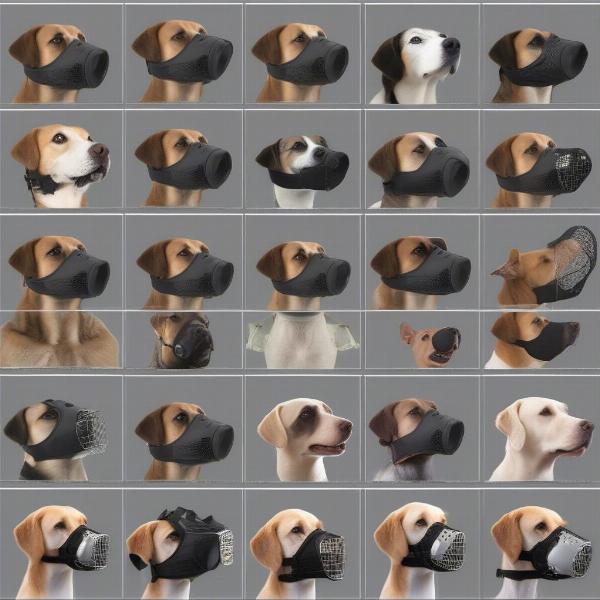Dog mouth guards, also known as muzzles, often evoke mixed reactions. While some may associate them with aggression, they serve a variety of purposes beyond behavior modification. Understanding when and how to use a dog mouth guard is crucial for responsible pet ownership, ensuring both your dog’s safety and the safety of others. From vet visits to grooming sessions, a properly fitted mouth guard can be an invaluable tool.
Why Use a Dog Mouth Guard?
There are several situations where a dog mouth guard can be beneficial:
- Veterinary Visits: During examinations or procedures, even the most gentle dog might react out of fear or pain. A mouth guard protects the veterinary staff from potential bites.
- Grooming: Similar to vet visits, grooming can be stressful for some dogs. A mouth guard can prevent bites if the dog becomes agitated during nail trimming, hair cutting, or other grooming procedures.
- Introducing New Dogs: While careful introductions are essential, a mouth guard can offer an extra layer of safety during initial meetings between unfamiliar dogs.
- Preventing Self-Harm: Dogs with injuries or medical conditions might lick or bite at affected areas, hindering the healing process. A mouth guard can prevent this self-inflicted trauma.
- Behavioral Modification: For dogs exhibiting aggressive tendencies, a mouth guard can be a temporary management tool while working with a professional trainer to address the underlying behavioral issues.
Choosing the Right Dog Mouth Guard
Selecting the appropriate mouth guard is crucial for your dog’s comfort and safety. There are several types available, each with its own pros and cons:
- Basket Muzzles: These allow for panting, drinking, and even treat-taking, making them a comfortable and humane option for most situations.
- Soft Muzzles: Made from fabric or nylon, these are lightweight and less restrictive but offer less bite protection. They’re suitable for short-term use, such as quick vet visits.
- Short-Snouted Dog Muzzles: Designed specifically for brachycephalic breeds like Bulldogs and Pugs, these muzzles accommodate their shorter noses.
 Different Types of Dog Muzzles
Different Types of Dog Muzzles
How to Introduce a Dog Mouth Guard
Introducing a mouth guard gradually and positively is essential to avoid creating negative associations. Start by letting your dog sniff and investigate the muzzle. Reward them with treats and praise. Gradually associate the muzzle with positive experiences, like walks or playtime. Never force the muzzle onto your dog, as this can cause fear and anxiety.
When Not to Use a Dog Mouth Guard
While mouth guards can be helpful tools, they are not appropriate for all situations. Never use a muzzle as a punishment or for long periods without supervision. Dogs should never be left alone while wearing a muzzle, especially those that restrict panting. Avoid using muzzles on dogs with breathing problems or those prone to overheating.
Conclusion
Dog mouth guards are valuable tools when used responsibly and for the right reasons. Choosing the correct type and introducing it positively is key to ensuring your dog’s comfort and safety. Remember, a mouth guard is not a solution for underlying behavioral issues and should be used in conjunction with professional training if necessary.
FAQs
- Can my dog drink water with a muzzle on? It depends on the type of muzzle. Basket muzzles allow for drinking, while others may not.
- Are muzzles cruel? No, when used correctly and for the appropriate reasons, muzzles are not cruel. They can even prevent a dog from injuring itself or others.
- How do I choose the right size muzzle for my dog? Measure your dog’s snout circumference and length to ensure a proper fit. Consult a pet store professional if needed.
- Can I leave my dog alone with a muzzle on? No, dogs should never be left unsupervised while wearing a muzzle.
- What if my dog tries to paw off the muzzle? This is a common reaction. Continue positive reinforcement and ensure a comfortable fit. If the problem persists, consult a professional trainer.
- Are there alternatives to using a muzzle? Depending on the situation, alternatives may include behavioral modification training, desensitization techniques, or medication.
- How can I clean my dog’s muzzle? Follow the manufacturer’s instructions for cleaning. Most muzzles can be washed with soap and water.
Related Articles:
About ILM Dog:
ILM Dog is your trusted international resource for all things dog-related. We provide expert advice on dog breeds, health and medical care, training and behavior, nutrition, grooming, exercise, puppy care, senior dog care, traveling with dogs, and product recommendations. Whether you’re a seasoned dog owner or just starting your journey, we’re here to help you provide the best possible care for your furry friend. Contact us for expert advice at [email protected] or call us at +44 20-3965-8624. We look forward to hearing from you!